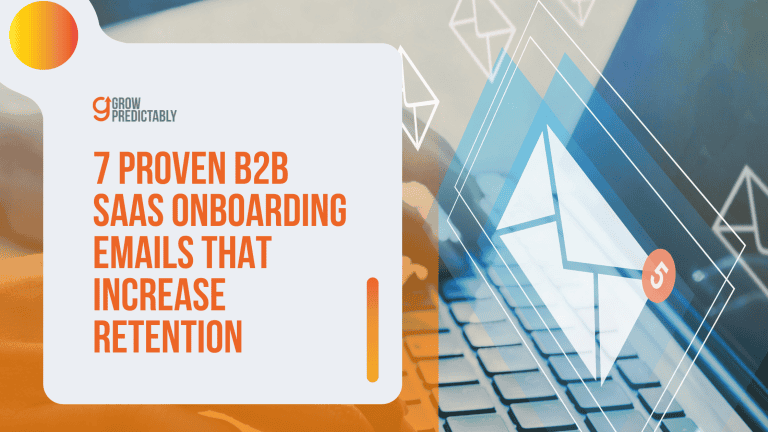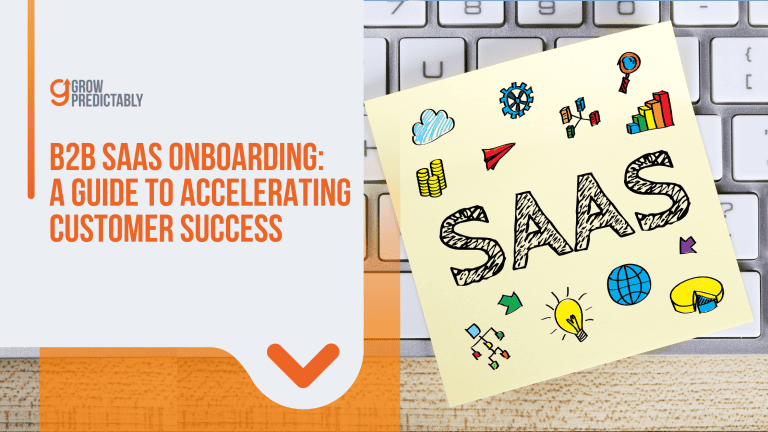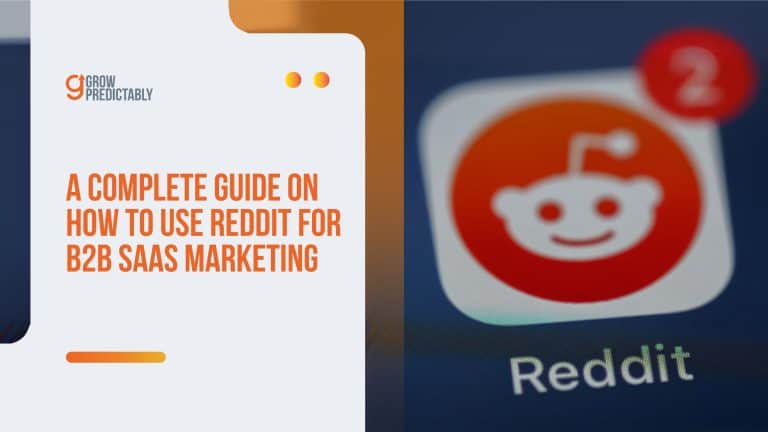Your Blueprint to Thought Leadership Content for B2B SaaS Executives
Successful thought leadership isn’t just about posting on LinkedIn or publishing occasional blog posts.
It’s about becoming the go-to expert your customers turn to when they need answers.
Consider HubSpot—not only did they build a CRM, but they also wrote the playbook on inbound marketing that everyone uses today.
They didn’t just sell software; they changed how marketing works.
That’s thought leadership at work.
Today, let’s unfold the blueprint for thought leadership content for B2B SaaS executives.
The Power Across the Sales Funnel
The real power of thought leadership lies in how it influences every stage of your sales funnel.
From capturing initial attention to converting skeptical prospects into loyal customers—it’s like having a sales team that works 24/7 without the commission checks.
We’ll explore exactly how thought leadership impacts each stage and provides tangible benefits, like shorter sales cycles and increased deal sizes.
A well-executed thought leadership strategy can optimize each stage, ensuring higher engagement and conversion rates.
Common Challenges—and How to Overcome Them
Many B2B SaaS companies struggle with implementing effective thought leadership due to common challenges:
- Resource Allocation: Limited time and budget can hinder consistent content creation.
- Stakeholder Buy-In: Without support from leadership, thought leadership initiatives may falter.
- Maintaining Originality: Standing out in a crowded market requires valuable insights that are unique, not generic content.
Solutions:
- Prioritize and Plan: Allocate resources by creating thought leadership content calendar aligned with strategic goals.
- Secure Leadership Support: Present data-driven ROI projections to stakeholders to gain buy-in.
- Leverage Internal Expertise: Encourage contributions from various teams to generate diverse and original content.
Let’s delve into how thought leadership can transform your sales funnel and provide you with a strategic advantage.
What’s the right balance between personal and company branding?
To strike the right balance between personal and company branding in B2B SaaS thought leadership, align your personal voice with your company’s overarching mission and values.
Your personal brand should amplify, not compete with, your company’s identity. Start by defining a few core themes that overlap with your expertise and your company’s goals, such as innovation, customer success, or industry trends.
Create thought leadership content where your personal insights complement your company’s offerings. For example, share personal experiences that highlight challenges your product solves or trends your company is pioneering.
Leverage platforms like LinkedIn for personal posts, while maintaining consistency with the tone and branding of your company’s website and social channels.
A practical approach is to maintain a 70-30 split: 70% personal insights showcasing expertise and 30% direct alignment with the company’s objectives. This way, you build authenticity and thought leadership while reinforcing your company’s credibility and mission.
How Thought Leadership Transforms the B2B SaaS Sales Funnel
A thought leadership strategy can serve as a foundation for guiding prospects through each stage of the funnel.
Understanding the customer journey is crucial here.
Thought leadership isn’t just a top-of-the-funnel activity; it’s a powerful tool that influences every stage of the sales funnel.
Here’s how you can do that using the Customer Value Journey’s eight different stages:

Awareness Stage: Capturing Attention
At this stage, your goal is to get noticed.
Actionable Steps:
- Publish Original Research: Offer fresh, valuable insights that address B2B SaaS industry pain points.
- Leverage SEO: Optimize content with keywords your target audience is searching for.
- Utilize Social Platforms: Share thought-provoking content on LinkedIn and industry forums.
Engagement Stage: Building Interest
Your prospects are paying attention but aren’t yet convinced.
Actionable Steps:
- Create In-Depth Blog Posts: Provide valuable information that solves real problems.
- Host Webinars: Engage with your target audience through interactive sessions.
- Encourage Interaction: Respond to comments and foster discussions.
Subscribe Stage: Gaining Trust
Turn interested visitors into subscribers.
Actionable Steps:
- Offer Valuable Lead Magnets: Provide exclusive e-books, whitepapers, or webinars.
- Personalize Communication: Use email campaigns to deliver tailored content.
Convert Stage: Encouraging Action
Now, prospects are considering a purchase.
Actionable Steps:
- Showcase Case Studies: Highlight success stories from clients in similar industries.
- Provide Product Demos: Offer trials or live demonstrations to showcase value.
- Address Objections: Create B2B SaaS content that tackles common concerns.
Excite Stage: Delivering Value
You’ve made the sale; now it’s time to exceed expectations.
Actionable Steps:
- Provide Onboarding Resources: Offer guides and tutorials for new users.
- Share Advanced Insights: Continue delivering valuable content to enrich the customer experience.
Ascend Stage: Upselling and Expansion
Encourage customers to upgrade or purchase additional products.
Actionable Steps:
- Identify Needs: Use data to understand customer usage and identify opportunities.
- Offer Premium Content: Provide valuable insights into advanced features and their benefits.
Advocate Stage: Cultivating Loyalty
Transform satisfied customers into advocates.
Actionable Steps:
- Encourage Reviews and Testimonials: Make it easy for customers to share their positive experiences.
- Engage on Social Media: Highlight customer stories and successes.
Promoter Stage: Leveraging Word of Mouth
Empower your advocates to promote your brand.
Actionable Steps:
- Create Referral Programs: Reward customers for bringing in new business.
- Host Community Events: Build a community around your brand.
By integrating thought leadership into each stage, you not only attract potential customers but also build lasting relationships that drive growth.
How to Approach Thought Leadership – 6 Essential Steps

A well-defined strategy is the backbone of effective thought leadership.
Here’s where business leaders should get started:
1. Identify Your Niche
The first step is figuring out where you can provide unmatched value.
Thought leadership thrives in specificity. Instead of trying to cover everything in your industry, hone in on a niche where your expertise or product truly shines.
For example, if your B2B SaaS product supports customer success teams, focus on becoming a voice of authority in customer retention strategies or onboarding success metrics.
Use tools like Google Trends or SEMRush to explore high-interest topics in your niche or LinkedIn polls to engage your target audience and pinpoint pressing issues they care about.
- Assess Your Expertise: List the core competencies of your company.
- Understand Market Needs: Research what your audience cares about.
- Find the Overlap: Pinpoint where your expertise meets market demand.
- Analyze Competitors: Identify gaps in their content marketing strategy that you can fill.
These insights can help you refine your niche with precision.
2. Understand Your Target Audience Deeply
Any content marketing tactic won’t land unless you know exactly who you’re speaking to.
This means understanding your audience’s pain points, aspirations, and even the language they use.
For example:
- CEOs want strategic insights that impact revenue.
- CMOs crave innovative marketing strategies.
- Content creators want actionable frameworks they can apply right away.
FAST HACK: Tap into LinkedIn Sales Navigator to discover your audience’s professional interests, challenges, and trends. It’s a goldmine for understanding their mindset and tailoring your messaging.
- Develop Customer Avatars: Use the Customer Avatar Canvas to create detailed profiles of your ideal customers.
- Gather Insights: Conduct surveys and interviews to learn about their challenges.
- Map Customer Journeys: Understand the touchpoints and decision-making processes.
3. Create a Content Calendar
Consistency is key to building thought leadership. A well-structured content calendar ensures you stay relevant and on message, this step is a must in content marketing best practices.

Plan content around major industry events, product launches, or quarterly business goals. Include a mix of formats—blogs, webinars, infographics, and LinkedIn posts—to cater to diverse audience preferences.
Consider themes for each month. For example, “January: Growth Strategies for B2B SaaS Startups” or “June: Mid-Year Marketing Optimization Tips.”
Tools like Trello or Notion are perfect for mapping out your calendar.
- Set Clear Goals: Define what you want to achieve with your content.
- Plan Content Types: Mix blogs, webinars, videos, and social posts.
- Schedule Regularly: Consistency is key—plan content for at least three months ahead.
- Assign Responsibilities: Determine who will create, review, and publish content.
Content repurposing should also be in mind whenever you create evergreen content.
Repurpose long-form content like research reports into smaller pieces—quotes for LinkedIn, short articles, or even email campaigns.
Incorporating a robust thought leadership content strategy into your calendar ensures your messaging remains consistent and impactful.
This maximizes output with minimal extra effort.
4. Produce Original Research
Nothing screams thought leadership louder than exclusive insights.
Original research positions your brand as a trailblazer and gives your audience something fresh they can’t find elsewhere.
- Design Surveys: Ask questions that uncover new industry insights.
- Analyze Data: Use statistical methods to find meaningful patterns.
- Share Findings: Publish reports and infographics to present your research.
Remember to publish your findings in a visually compelling format, like a downloadable whitepaper or an interactive infographic.
Highlight actionable takeaways to make it shareable.
A thought leadership content strategy that leverages original research can set your brand apart by offering exclusive, high-value insights.
5. Develop a Unique Voice
Your voice is what makes your content memorable. Avoid generic corporate tones.
Instead, let your brand personality shine through.
Whether it’s conversational, authoritative, or witty, consistency is the goal.
Take cues from brands like Drift or HubSpot, which strike a balance between approachable and professional.
Test different tones through A/B testing in email campaigns or social media posts to see what resonates most.
- Define Your Tone: Decide if you’ll be authoritative, casual, or somewhere in between.
- Be Consistent: Maintain the same voice across all platforms and content types.
- Show Personality: Let your company’s character shine to connect with your audience.
Use tools like Grammarly or Hemingway Editor to refine your tone and ensure clarity across all content.
6. Build Your Distribution Channels
Even the best content won’t create an impact if no one sees it.
Building strong distribution channels—email, social media, partnerships, and paid promotions—ensures your message reaches the right people.
LinkedIn is especially powerful for B2B SaaS executives.
Did you know LinkedIn has 10 million C-level executives and 65 million business decision-makers? (Source)

Experiment with a mix of organic and paid distribution to scale your reach.
Share posts from your personal profile to establish credibility and amplify your content’s visibility through employee advocacy programs.
- Leverage Owned Media: Use your website, blog, and email list.
- Collaborate with Influencers: Partner with industry leaders for joint content.
- Utilize Paid Promotion: Invest in targeted ads to reach a broader audience.
By following this strategic approach, you’ll position your company as a thought leader that provides genuine value to your audience.
Selecting 5 Effective Content Types for Maximum Impact
Different content formats serve different purposes in building thought leadership.
For B2B executives, leveraging multiple formats is essential to cater to diverse audience preferences and maximize reach.
Some formats are ideal for establishing authority through in-depth insights, while others are perfect for sparking engagement or driving action.
By using the right format at the right time, you can amplify your thought leadership message and strengthen your credibility.
Below is a breakdown of five powerful content formats, when to use them, and key considerations for success.
| Content Format | Best Times to Use | Key Considerations |
|---|---|---|
| 1. Long-Form Blog Posts | When sharing in-depth insights, step-by-step guides, or analyses on industry trends. | Ensure content is well-structured, research-backed, and actionable. Use headings, bullet points, and visuals to improve readability. |
| 2. Webinars | For interactive discussions or when addressing complex topics that require detailed explanations. | Collaborate with industry experts to add credibility. Keep presentations visually engaging and leave time for Q&A to foster interaction. |
| 3. Case Studies | To showcase real-world success stories and build trust with potential clients. | Focus on measurable outcomes and include direct quotes or testimonials. Make it relatable by highlighting challenges and solutions. |
| 4. Short Video Content | Ideal for quick tips, industry updates, or thought-provoking insights on social platforms. | Keep videos under 2 minutes. Maintain authenticity with conversational tone and ensure good lighting and audio quality. |
| 5. Infographics | To simplify data-heavy insights or complex processes into easily digestible visuals. | Focus on clarity and design. Use bold headings and concise text. Tools like Canva or Venngage can help streamline creation. |
How to Use Content Formats Strategically
- Start with Long-Form Content: Use blogs or whitepapers to establish expertise on a topic.
- Repurpose Across Formats: Turn that blog into a webinar discussion, break it into short videos for LinkedIn, and summarize findings in an infographic.
- Test and Iterate: Use performance metrics to understand what format resonates most with your audience and refine your strategy accordingly.
By diversifying your content formats and staying consistent, you’ll create a broader and more impactful presence as a thought leader.
You can use different formats to maximize reach. For example, transform a webinar into a series of blog posts or infographics.
Assembling Your Thought Leadership Team
Effective thought leadership requires dedicated roles with clear responsibilities.
The Role of the CMO
Responsibilities:
- Strategic Alignment: Ensure thought leadership aligns with overall marketing and business goals.
- Resource Allocation: Allocate budget and resources effectively.
- Brand Oversight: Maintain consistent messaging and branding.
The Role of the Thought Leadership Director
Responsibilities:
- Content Strategy Execution: Develop and manage the content calendar.
- Collaboration: Work with subject matter experts across the organization.
- Quality Control: Ensure all content meets high standards.
- Performance Tracking: Monitor metrics and adjust strategies accordingly.
Collaboration Between Roles
- Regular Meetings: Facilitate communication between the CMO and Thought Leadership Director.
- Shared Goals: Establish common KPIs to measure success.
- Feedback Loops: Implement processes for continuous improvement.
In smaller organizations, these roles may overlap, but it’s crucial to designate someone responsible for thought leadership to maintain focus and consistency.
How to Engage Your Audience Effectively
Engaging with your target audience as a thought leader goes beyond posting valuable content.
True engagement happens when your audience feels seen, heard, and valued.
An effective thought leadership content strategy also ensures every interaction with your audience reinforces your authority and relevance.
While traditional methods like responding to comments or sharing updates are helpful, thought leaders in B2B SaaS need to adopt innovative approaches to stand out.
Below are unique and uncommon ways to engage with your audience across digital platforms.
1. Create Exclusive Micro-Communities
Instead of focusing solely on large-scale audience engagement, build exclusive micro-communities where your followers can interact with you directly.
Platforms like LinkedIn Groups or private Slack channels allow for focused discussions around niche topics.
This fosters deeper relationships and positions you as an approachable authority.
If your niche is on the role of AI in no-code and low-code automation, then creating private groups that group enthusiasts and experts on the same topic can help you demonstrate credibility as you lead your growing community online.
Just like this one on LinkedIn.

The 1,900-strong private group targets CTOs, CIOs, and COOs to join their community, where everyone can share their expertise and experience around coding, automation, digital apps, and more.
2. Leverage Personalized Video Replies
When someone comments on your post or sends a thoughtful message, respond with a short, personalized video instead of text.
This method is unexpected and leaves a lasting impression.
It humanizes your interaction and shows your audience that you value their input enough to go the extra mile.
3. Conduct Real-Time Polls on Hot Topics
Audience engagement thrives on relevance. Use real-time polls to tap into what’s top-of-mind for your audience.
Platforms like Twitter and LinkedIn make it easy to gauge opinions or spark debates on emerging industry trends.
These polls not only provide valuable insights but also encourage interaction.
Just like this one below from SaaStr that gauges the target audience’s take on segmentation in measuring customer retention and revenue.

Aside from these three unique methods you can leverage to keep the engagement between you and your audience as a thought leader, here are more tested and proven ways that a lot of brands and personalities use.
- Incorporate Polls: Use live polls to engage participants.
- Facilitate Q&A Sessions: Allocate ample time for audience questions.
- Provide Value: Focus on solving real problems, not just promoting products.
- LinkedIn Pulse Articles: Publish thought-provoking articles.
- Hashtag Campaigns: Use relevant hashtags to increase visibility.
- Engage in Discussions: Comment on industry topics and engage with others’ content.
- Create Private Groups: Use platforms like Slack or LinkedIn Groups.
- Foster Interaction: Encourage members to share insights and ask questions.
- Moderate Effectively: Ensure the community remains valuable and on-topic.
- Testimonials and Reviews: Invite customers to share their experiences.
- Case Study Participation: Collaborate with clients to showcase success stories.
- Content Contributions: Accept guest posts or articles from industry peers.
TIP: Always respond promptly to audience interactions to foster a sense of community and trust.
Measuring Success and Demonstrating ROI
Constantly creating thought leadership content is not enough; you also have to gauge how each content that you release is performing.
A thought leadership strategy that includes clear KPIs ensures that your efforts are both measurable and impactful.
Quantifying the impact of thought leadership will help any B2B thought leader or brand justify investment and guide future strategies.
Key Performance Indicators (KPIs)
Engagement Metrics:
- Content Views and Reads: Monitor page views and read times.
- Social Interactions: Track likes, shares, comments, and mentions.
- Event Attendance: Measure registrations and participation in webinars or events.
Lead Generation Metrics:
- Conversion Rates: Assess the percentage of content consumers who become leads.
- Lead Quality: Analyze the qualification levels of leads generated.
- Cost Per Lead: Calculate the investment required to acquire each lead.
Brand Authority Metrics:
- Backlinks and Mentions: Monitor referrals from reputable sites.
- Share of Voice: Compare your industry’s conversation volume to competitors.
- Media Coverage: Track press mentions and speaking invitations.
Tools for Measurement
- Google Analytics: For website traffic and behavior analysis.
- CRM Systems: Like Salesforce or HubSpot for lead tracking.
- Social Media Analytics: Built-in platform insights or tools like Hootsuite.
Analyzing the Data
Steps:
- Set Benchmarks: Establish baseline metrics before launching initiatives.
- Regular Reporting: Create monthly or quarterly reports to track progress.
- Adjust Strategies: Use findings to refine content, distribution channels, and tactics.
Demonstrating ROI
Approach:
- Attribute Revenue: Link closed deals to touchpoints with thought leadership content.
- Highlight Cost Savings: Show how organic content reduces reliance on paid advertising.
- Present Case Studies: Use examples where thought leadership directly influenced conversions.
By effectively measuring and demonstrating ROI, you’ll secure ongoing support and resources for your thought leadership programs.
FAQs
Key Takeaways
Thought leadership is more than a marketing strategy—it’s a transformative approach that can propel your B2B SaaS company to new heights.
- Integrated Approach: Thought leadership should permeate every stage of the sales funnel.
- Strategic Planning: A clear strategy with defined goals and metrics is essential.
- Quality Over Quantity: Focus on producing valuable, original content that resonates with your audience.
- Team Effort: Success requires collaboration across roles, with dedicated ownership.
- Adapt and Evolve: Stay ahead by embracing industry trends and emerging technologies.
Action Steps to Get Started
A successful thought leadership strategy begins with a first step. Get started on these now:
- Audit Your Current Efforts: Identify what’s working and where gaps exist.
- Develop a Strategy: Use the provided checklists to plan your approach.
- Allocate Resources: Assign roles and secure necessary tools and budget.
- Create a Content Calendar: Plan your content and set deadlines.
- Engage and Measure: Interact with your audience and track performance.
Refine Continuously: Use data and feedback to improve your strategy over time.








